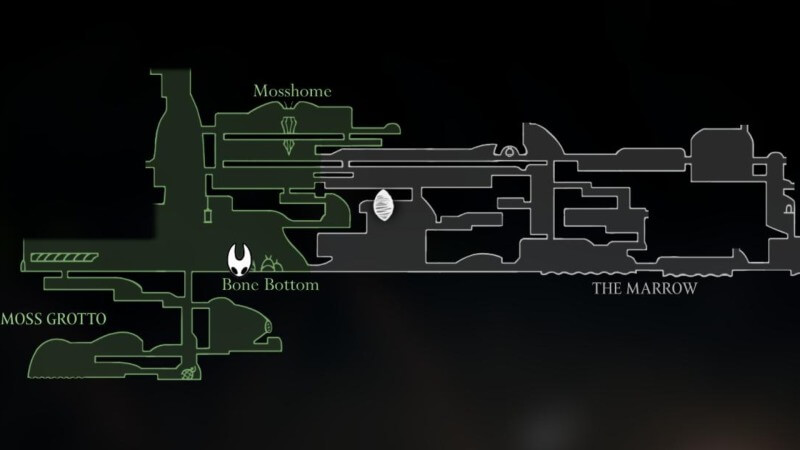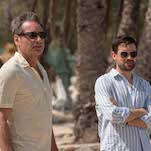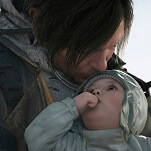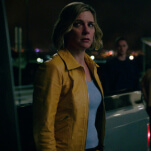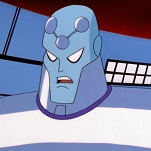So, if you’ve never played these games, you’re probably wondering how, if I have access to a map, I’m managing to get lost without using this other tool called the Compass. That’s because the Compass tool is the only way that you can tell where your character is on the map. Obviously, on a real-life paper map that you carry around with you, there would be no magical “You Are Here” sticker that moves around along with you. Because the characters in Hollow Knight and Silksong are visibly carrying around actual paper maps, it makes sense that they need to use their own brains to figure out where they are, or instead use the magical Compass tool to see themselves on the map. This is part of why I feel bad complaining about it; I understand it.
As somebody who gets lost easily, though, it’s tough. And I don’t mean it’s “tough” the way that other things in Silksong can be tough—the long runbacks to certain boss fights, for example, or the lack of save points during some of the game’s more challenging platforming sections. That stuff is hard for me, but I appreciate the challenge. I’m also the type of player who laughs rather than rage-quitting when it comes to some of the game’s hostility, too, like the notorious bench in Hunter’s March. I feel like it’s on me to adjust to what the game asks of me, and to stop playing—or, at the very least, take a break—if I can’t handle what Silksong’s developers are dishing out.
I just don’t feel that way about the Compass. Maybe because this is one of the few skill checks in the game that I can’t surpass, and that’s on me for not being able to “get good” at this, no matter how hard I have tried over the years. (It’s also not just on me, given that there’s a pretty popular mod to make the Compass equipped all the time in Silksong without it using up an item slot.) The thing that gets to me, though, is that this Compass functionality is something that I’ve never seen any other video game do. When you look at a map in a game, you always get to see where you are on it. Why take that away? It’s an odd decision, and it seems to be in conflict with how much of both Hollow Knight games are focused on exploration, discovery, and secrets.
It’s also odd given that other modern games in this genre have leaned towards making their maps easier to use, rather than more difficult. Prince of Persia: The Lost Crown even includes a feature where players can take screenshots of certain areas they want to return to later, and pin these specific screenshots to parts of the map. That way, whenever you get a new traversal ability, you can open the map and check all of the screenshots associated with different areas and see if any of them depict roadblocks that you might now be able to get past.
Prince of Persia: The Lost Crown includes lots of other settings that Silksong doesn’t have, like adjustments to make combat and traversal easier, so clearly there’s a design ethos that’s different there. But even Animal Well, which is so often opaque, gives the player the ability to see where they are on the map. One of the first upgrades in Animal Well is the Pencil, which allows the player to draw on the map and write notes to themselves; it’s not as comprehensive as taking a screenshot in The Lost Crown, but it’s still a lot more useful than most other games, since you can draw in freehand and make whatever esoteric notes you want. It’s clear that Animal Well’s design ethos is about encouraging the player to take these notes in-game, in part so that they always understand where they are now and where they might want to revisit. In my view, these elements are key to any side-scroller that has huge, complex areas that have to be revisited again and again.
There’s so much else that’s difficult in Silksong—the platforming, the enemy movements, the boss fights—that adding a layer of difficulty to using the map does seem like it would be on brand. But it doesn’t feel like the same type of difficulty, if we can even call it “difficulty” so much as “inexplicable inconvenience.” In the first Hollow Knight, having to use up an ability slot on the Compass was a disappointment, too, but it wasn’t as noticeable because the game didn’t have as many abilities in total. In Silksong, there are way more abilities and tools to discover, and the other abilities that fit into the same category as the Compass are really helpful. It’s a shame to not get to use them because the Compass has to be there in order for me to actually know where I am.
It’s not like this is a challenge that’s fun or interesting to learn how to overcome. For me, it’s just a hurdle, end of story. But I still have to admit that the animations of Hornet and, originally, the Hollow Knight holding up the paper map are so cute that I might have to concede everything. Like I said before, the paper maps in my glovebox don’t show where I am, either, and so why would theirs? Is this the Silksong developers’ way of indicating, in a very sweet way, that it would make a lot more sense if the characters didn’t know where they are on these maps, because they’re physical maps? It’s my best guess at the intention here, and again, I admit this makes a lot of sense. It does make the game harder for me personally, but it’s Silksong, so maybe I should just be grateful that the map isn’t also adding some sort of papercut damage every time I use it. I haven’t completed Act 3 yet, though, so I guess I shouldn’t speak too soon about that one… or give Team Cherry any new ideas.
Maddy Myers has worked as a video game critic and journalist since 2007; she has previously worked for Polygon, Kotaku, The Mary Sue, Paste Magazine, and the Boston Phoenix. She co-hosts a video game podcast called Triple Click, as well as an X-Men podcast called The Mutant Ages. When she is not writing or podcasting, she composes electro-pop music under the handle MIDI Myers. Her personal website is midimyers.com.
